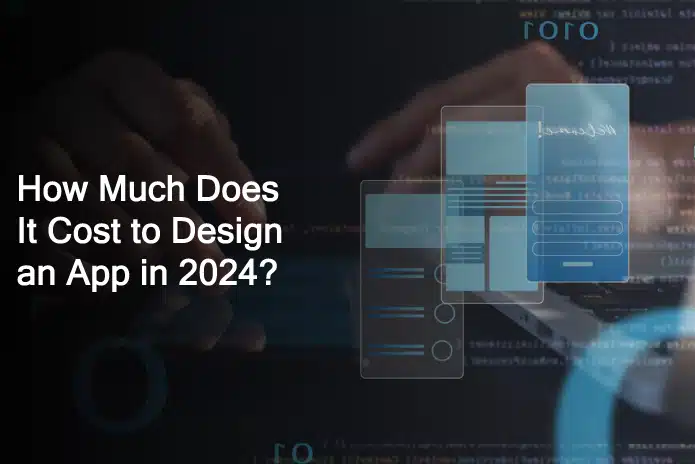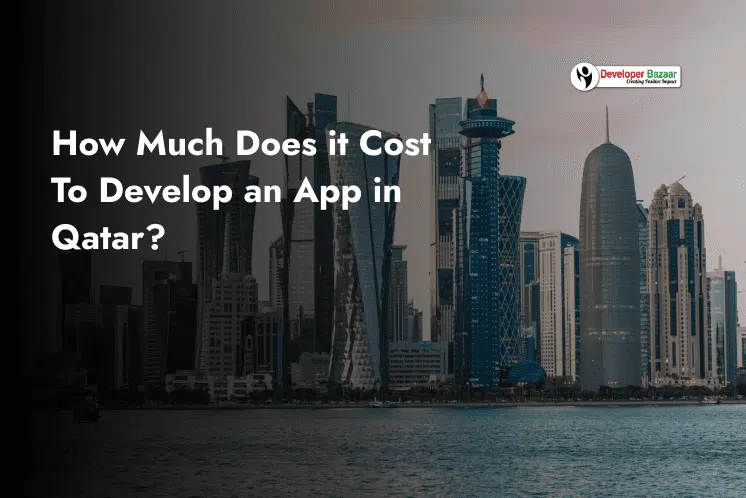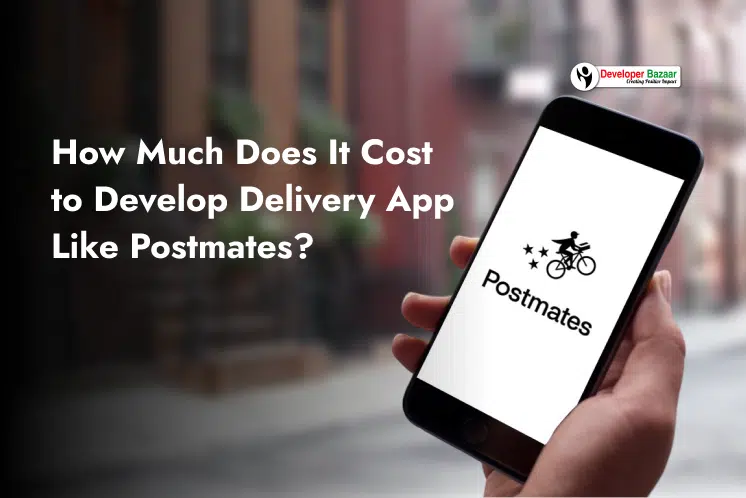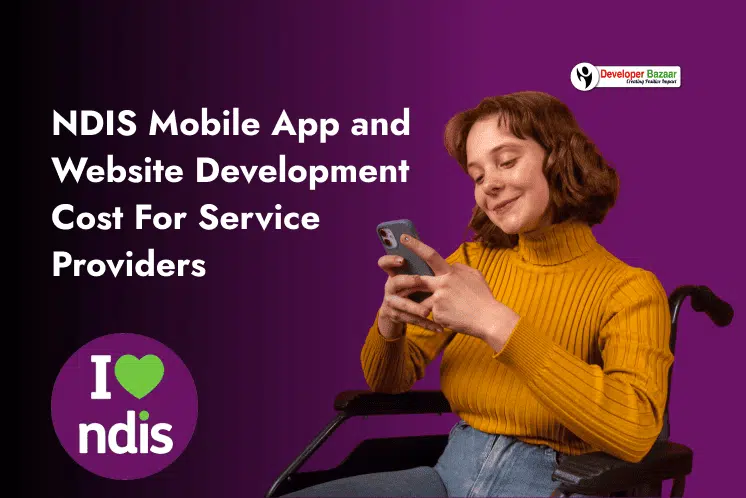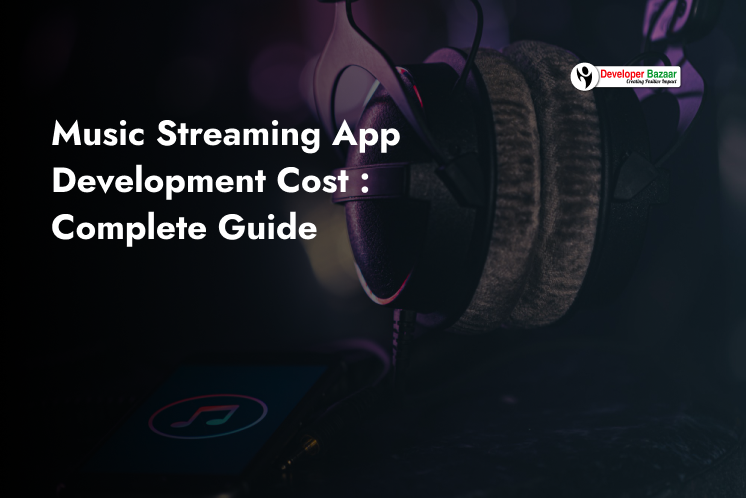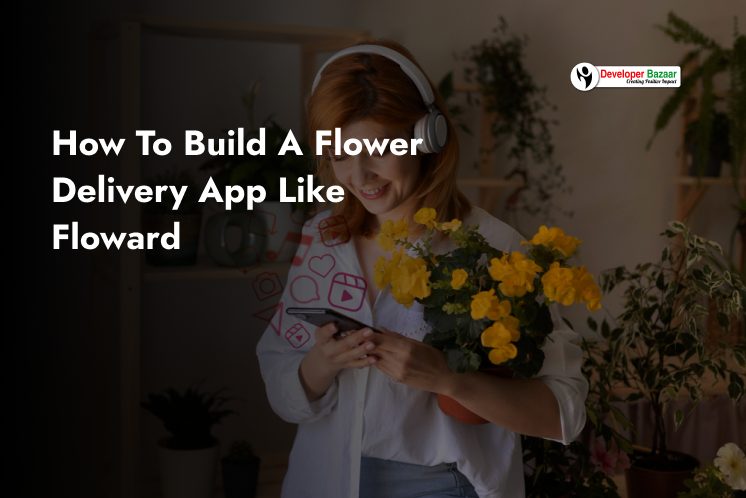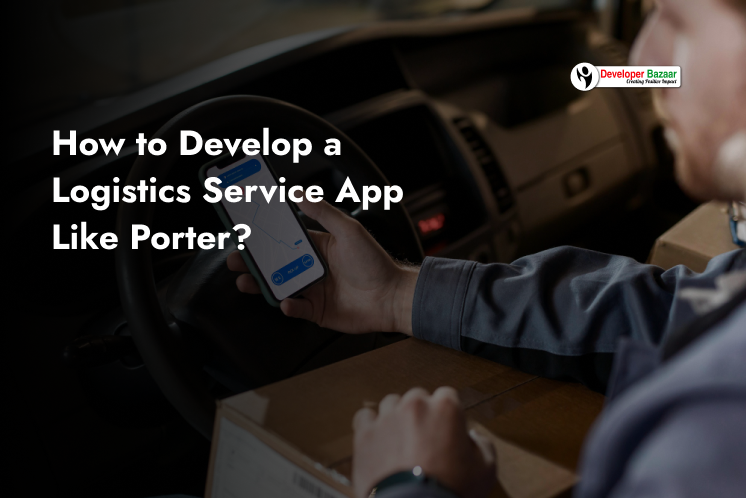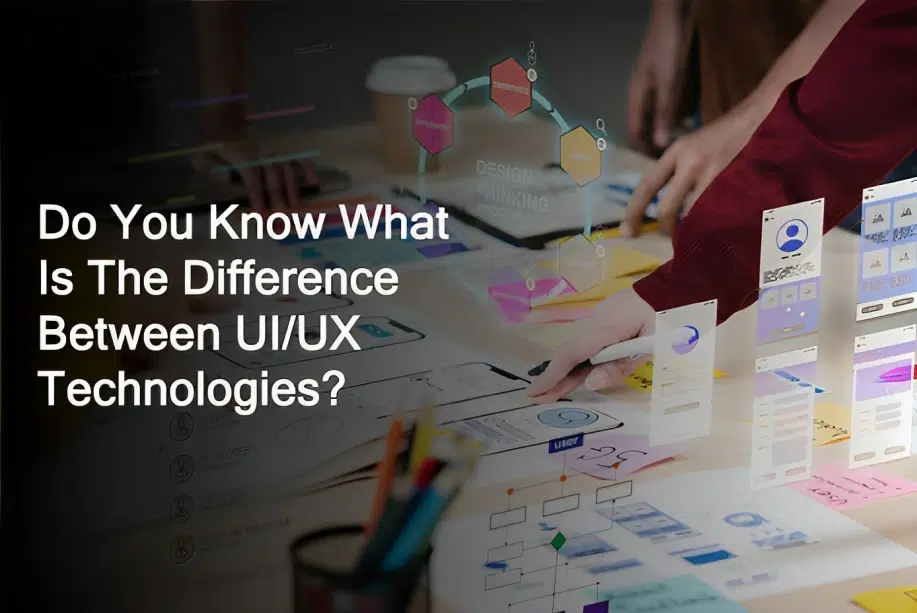Table of Contents
ToggleThe cost of designing a mobile app can be different based on how big and complicated the project is. Usually, it costs between $2,000 to $25,000 to design a mobile app.
In 2023, people around the world downloaded about 257 billion apps, showing just how popular mobile apps have become. Another report says that by 2027, the total money made from mobile apps is expected to reach $673.80 billion, growing at a rate of 8.83% each year from 2022 to 2027.
The growing use of smartphones and tablets, along with the need for businesses to have an online presence, is boosting the demand for app design services. With so many people using mobile apps daily, it’s clear why this demand is increasing. According to a report, 82% of users say that slow page speeds and bad experiences affect their buying decisions, and 53% of mobile users will switch to another company if a website takes more than three seconds to load.
In this blog post, we’ll look at what goes into the cost of designing a mobile app and share some tips on how to keep those costs down. But first, let’s talk about the factors that influence mobile app design costs.
Factors Influencing App Design Costs
The cost of designing an app depends on several important things. Knowing what these are can help you figure out how much money you’ll need to spend on designing your app. Let’s break down all the factors that influence the cost of designing a mobile app’s user interface in simple terms.
1. Complexity of the App:
The design cost of your app depends a lot on how complex the app is. More complex apps need more time, effort, and expertise to design. Let’s break down how complexity affects costs into three categories: simple apps, moderately complex apps, and highly complex apps.
1. Simple Apps –
Simple apps are easy to use and have a clean, simple design. They don’t have many screens or features and usually don’t need to connect to a backend system. Examples of simple apps are:
- Calculator Apps: Basic calculators or unit converters with a simple user interface and limited functionality.
- To-Do List Apps: Simple task management apps with basic features such as adding, editing, and deleting tasks.
- Basic Information Apps: Apps that display static information, such as a digital brochure or a simple contact directory.
Design Considerations for Simple Apps:
- Minimal Features: The focus is on essential features without any advanced functionalities.
- Basic UI/UX Design: Simple and clean design with standard UI components and minimal customization.
- No Backend Integration: These apps often do not require complex backend systems or databases.
Cost Estimate for Simple Apps:
| Design Stage | Estimated Hours | Hourly Rate (USD) | Total Cost (USD) |
|---|---|---|---|
| Research and Discovery | 10-20 | 50-150 | 500-3,000 |
| Wireframing | 20-30 | 40-100 | 800-3,000 |
| Prototyping | 20-40 | 50-150 | 1,000-6,000 |
| UI Design | 40-60 | 50-150 | 2,000-9,000 |
| UX Design | 30-50 | 50-150 | 1,500-7,500 |
| Testing and Iteration | 20-40 | 40-100 | 800-4,000 |
| Total | 140-240 | 6,600-32,500 |
👀 Also Read: How Much Does It Cost to Create an App in Ukraine?
2. Moderately Complex Apps –
Moderate apps are more advanced than simple ones. They have lots of features and screens, and sometimes they connect to a backend. These apps give users more things to do and a better experience. Examples are:
- Fitness Tracking Apps: Apps that track workouts, provide fitness plans, and allow users to share progress on social media.
- E-Commerce Apps: Basic online stores with product listings, shopping carts, and payment processing.
- Social Networking Apps: Apps with user profiles, messaging, and social sharing features.
Design Considerations for Moderately Complex Apps:
- Enhanced Features: Includes functionalities such as user authentication, data storage, and social media integration.
- Custom UI/UX Design: Greater focus on the little things in the design, such as unique icons, animations, and dynamic components.
- Backend Integration: Requires connectivity with backend services for data management, user authentication, and other functionalities.
Cost Estimate for Moderately Complex Apps:
| Design Stage | Estimated Hours | Hourly Rate (USD) | Total Cost (USD) |
|---|---|---|---|
| Research and Discovery | 20-40 | 50-150 | 1,000-6,000 |
| Wireframing | 40-60 | 40-100 | 1,600-6,000 |
| Prototyping | 40-80 | 50-150 | 2,000-12,000 |
| UI Design | 60-120 | 50-150 | 3,000-18,000 |
| UX Design | 50-100 | 50-150 | 2,500-15,000 |
| Testing and Iteration | 40-60 | 40-100 | 1,600-6,000 |
| Total | 250-460 | 11,700-63,000 |
👀 Also Read: How Much Does Pinterest Like App Development Cost?
3. Highly Complex Apps –
Apps that are highly complex typically have a lot of backend integration, sophisticated features, and sometimes custom-built user interface elements. These applications meet a variety of user needs and offer complete solutions. As examples, consider:
- Advanced E-Commerce Platforms: Large-scale online stores with complex features like inventory management, user reviews, personalized recommendations, and multiple payment gateways.
- Social Media Networks: Platforms similar to Facebook or Instagram, featuring advanced functionalities like real-time messaging, multimedia sharing, live streaming, and complex algorithms for content delivery.
- On-Demand Services Apps: Apps like Uber or Airbnb, which require real-time tracking, secure payment processing, and robust user management systems.
Design Considerations for Highly Complex Apps:
- Advanced Features: Incorporates complex functionalities such as real-time data processing, geolocation, machine learning, and AI.
- High-Quality UI/UX Design: Extensive customization, high design graphics, advanced animations, and user interaction designs.
- Extensive Backend Integration: Requires advanced backend systems, databases, and API integrations for smooth functionality.
Cost Estimate for Highly Complex Apps:
| Design Stage | Estimated Hours | Hourly Rate (USD) | Total Cost (USD) |
|---|---|---|---|
| Research and Discovery | 40-80 | 50-150 | 2,000-12,000 |
| Wireframing | 60-100 | 40-100 | 2,400-10,000 |
| Prototyping | 80-120 | 50-150 | 4,000-18,000 |
| UI Design | 120-200 | 50-150 | 6,000-30,000 |
| UX Design | 100-160 | 50-150 | 5,000-24,000 |
| Testing and Iteration | 60-100 | 40-100 | 2,400-10,000 |
| Total | 460-760 | 21,800-104,000 |
👀 Also Read: How Much Does It Cost to Create an App in Australia?
2. Platform:
There are more differences between the Android and iOS platforms than just how they look and work. Creating apps for Android requires addressing a wide variety of screen sizes, operating system versions, and device types, which calls for testing and adaptation across multiple configurations. On the other hand, iOS usually takes fewer versions to finalise due to its more defined ecosystem and more strict guidelines.
As a result, compared to iOS, the complexity of designing and developing an Android app frequently results in higher costs. These costs result from the extra time and effort needed to make sure that different Android devices and versions are compatible. In addition, the dispersed nature of the Android market requires careful planning and execution in order to guarantee a uniform user experience on all devices.
Android vs. iOS App Design Cost
Because of Apple’s strict guidelines and expectations, designing the user interface (UI) of mobile apps for iOS has historically been more expensive. But as time has gone on, the scenery has changed greatly. In order to guarantee a similar quality of applications in the Google Play Store, Google additionally improved its approval procedures for Android apps. As such, the gap in development costs has closed even though there are still hidden design differences between iOS and Android. These days, complexity of required functionalities, number of platforms to support, and device types targeted for the app are the main factors affecting design costs. This change highlights the need for a more equal comparison of the costs of custom app designs vs iOS.
Let us look at it from the iOS app design cost perspective first:
iPhone only – Designers of entry-level models are not required to create images specifically for retina displays. As a result, the projected costs fall between $3,000 and $10,000. This price range serves a wide range of customers looking for effective solutions without the extra trouble of producing high-resolution images for use with modern screen technologies.
iPhone 6 Plus and ahead – Applications made for the iPhone 6 and later models cost an extra 25% for UI/UX design. Because these devices have retina displays, high-resolution resources are required, which raises the cost of production. Following Apple’s strict guidelines for performance and design means paying close attention to every detail in design and functionality in order to deliver the best possible user experience on these platforms. Delivering smooth and attractive applications that appeal to users used to the high standards set by modern smartphone technology requires finding a balance between these factors. To satisfy the demands of this advanced market segment, developers and designers have to allocate resources carefully.
iPad – The cost of designing a mobile app is increased by 50% when designing an iPad app. This improvement requires close attention to high-resolution graphics and creating custom product designs to fit the larger screen and guarantee the best possible performance on iPads. The careful design and implementation of user interface elements that optimise the iPad’s speed and dimensions is necessary to ensure compatibility. In order to provide a better user experience, this process not only focuses on modifying current mobile app designs but also on using iPads’ special features.
Now talking of Android mobile app design:
Android devices are always changing because of Google’s Material Design guidelines for developing apps. Android app designers need to constantly adopt new frameworks and modern design ideas in order to remain relevant. Additionally, compared to iOS, designing for Android requires addressing a wider range of platforms, which automatically drives up the cost of mobile app design. In order to create simple and visually appealing experiences across a range of devices, designers must remain flexible in response to user preferences and technological advancements in this constantly shifting environment. Keeping up with these modifications guarantees that Android applications exceed user engagement and usability standards in addition to meeting functional requirements.
| Platform | Approximate cost, $/hr |
|---|---|
| iOS | 600 – 1000 |
| Android | 650 – 1200 |
👀 Also Read: How Much Does It Cost to Create an App in Canada?
3. Team location:
Geographical location has a major impact on the productivity and output of design teams, which are largely determined by the tools they use and their individual work processes. For example, a US designer might normally bill about $170 per hour for their services. On the other hand, an Eastern European designer might bill between $80 and $100 per hour on average. This pricing gap reflects variations in the cost of living and market demand in addition to regional economic factors.
Beyond financial issues, designers’ productivity and the level of their work can also be influenced by the tools and techniques they use. Designers in the US frequently have access to modern technology and software that may speed up their workflows and help them create complex designs more effectively. However, in order to meet their local market dynamics and client expectations, designers in Eastern Europe may use different sets of tools and processes.
While designers in the US and Europe aim to produce work of the highest quality, there can be important differences in terms of productivity and cost depending on the tools and working methods that they use. Businesses looking to effectively collaborate with design teams across different regions must be aware of these differences.
| Location of the team | Approximate cost, $/hr |
|---|---|
| US | 100 – 170 |
| Australia | 100 – 150 |
| Europe | 50 – 100 |
| UK | 50 – 100 |
👀 Also Read: How Much Does It Cost to Create an App in Vietnam?
4. Team type:
The cost of designing an app can vary a lot depending on the type of team you choose. Hiring an in-house team is usually the most expensive option. Outsourcing the work or hiring freelancers is generally more affordable. There are several factors to consider when deciding whether to hire freelancers, form an in-house team, or outsource to experts. We will provide a detailed checklist later to help you choose the best app design partner for your business.
When choosing between an in-house team, freelancers, or outsourced experts, consider how big and complex your project is. An in-house team allows for close collaboration and immediate availability, which is important for projects that need constant changes and a deep understanding of your company’s culture. However, this option often costs more due to salaries, benefits, and overhead expenses.
Freelancers offer flexibility and specialized skills that you can use on a per-project basis. This can be a cost-effective solution for smaller projects or when you need specific expertise without long-term commitments. However, managing freelancers can be challenging, especially if your project needs a lot of coordination and consistency.
Outsourcing to a dedicated team combines the benefits of specialized expertise and cost savings. These teams often have a proven track record and can provide full services from design to implementation. While this option might give you less direct control, it can be an efficient way to use global talent and manage larger projects without the costs of in-house employees.
Ultimately, your choice will depend on your project needs, budget, and long-term goals. We will help guide you through the decision-making process with our detailed checklist to ensure you find the best fit for your app design needs.
| Team type | Approximate cost, $/hr |
|---|---|
| In-house | 35,000 |
| Outsourced | 12,000 |
| Freelancer | 6,000 |
👀 Also Read: How Much Does It Cost to Create an App in Manila, Philippines?
5. Visual designs:
Choosing the look of your app, from colors to the final design, can greatly affect the overall cost. Colors are especially important because they set the app’s mood and highlight key parts. However, using too many colors can increase design costs due to the extra work needed to balance them. To save money, it’s best to use just 2-3 colors.
Other important visual elements include typography, moodboards, UI mockup samples, and final UI mockups. Typography, or the choice of fonts, helps convey the app’s personality. Moodboards are helpful for setting the app’s mood and are great for sharing your vision with the design team. UI mockup samples help determine the app’s layout and flow. Final UI mockups ensure the app looks polished and professional.
Consistency in these visual elements helps users feel comfortable and trust the app. Using the same color schemes, fonts, and design layouts makes it easier for users to navigate the app, improving their experience. Using design systems and templates can also make the design process faster and cheaper while keeping the quality high. Communicating well with your design team, using tools like moodboards and mockups, ensures everyone is on the same page, leading to a cohesive and appealing final product. Focusing on these elements can help create a user-friendly app without going over budget.
👀 Also Read: How Much Does It Cost to Develop an App in India?
6. Illustrations and animations:
With the exception of photos, all graphic elements are included in animations and illustrations. Icons, logos, vectors, GIFs, and other graphic formats are included in this category. Apps can be more easily recognised by using logos and icons, which are essential for branding. Animations give an app personality and interactivity, but because they take more time and work to create, they may increase design costs.
In order to create a visually engaging user experience, animations and illustrations are important. Advanced icons and logos may boost brand association while improving navigation by clearly and successfully communicating complex ideas. Because they can be resized without sacrificing quality, vectors are excellent and are ideal for responsive design. Animated components may give feedback, lead users through methods, and improve the energy and fun of the UI.
However, it’s important to balance these elements with performance considerations. Too many animations can slow down an app, leading to a poor user experience. Therefore, animations should be used strategically to improve functionality rather than hinder it.
Investing in high-quality illustrations and animations can greatly improve user engagement and retention. In a competitive digital landscape, thoughtful use of these graphic elements can make an app stand out, making it more memorable and user-friendly.
👀 Also Read: How Much Does It Cost to Create an App in Cairo, Egypt?
7. Functionality:
When creating an app, two main things affect the cost: the features you want and how complex they are. Features like in-app purchases and connecting with social media can make the design more expensive. To stick to a budget, it’s best to include only the essential features, such as user login, search, and sorting options.
Besides features, the design process itself also impacts the cost. This process has several stages, each adding to the overall expense.
First, there’s the concept and ideation phase, where ideas are brainstormed and initial sketches are made to outline the app’s functionality and look. This phase is important for setting a clear vision but can be costly because it needs creative input and time.
Next, in the wireframing and prototyping stage, detailed blueprints and interactive models of the app are created. These help visualize how the app will work and look, allowing early identification of potential problems. Investing in good wireframes and prototypes can save money later by avoiding expensive changes during development.
The user interface (UI) and user experience (UX) design phase is when the app starts to look and feel real. Good UI/UX design is important for user satisfaction and the app’s success, but creating a visually pleasing and easy-to-use interface requires special skills and tools, which add to the cost.
Finally, the development and testing phase ensures the app works well on different devices and operating systems. Thorough testing and debugging are necessary for a smooth user experience but also add to the cost due to the time and resources needed.
In summary, while features and complexity significantly affect the cost of app design, the design process itself—from brainstorming to testing—also plays a big role in the final expenses. Careful planning and prioritizing essential features, along with investing in quality design and testing, can help manage costs effectively.
👀 Also Read: AI in Banking – How Artificial Intelligence is Used in Banks?
How Does the App Design Process Impact Costing?
The three primary stages of the app design process are discovery, design, and development.
1. Discovery phase
Developing user profiles, researching competitors, creating user journey maps, and conducting market research are all part of the discovery phase, which involves fully understanding the issue at hand. This important stage finds market opportunities, gains insight into the competition, and completely analyses the needs and preferences of the target audience to set the foundation for successful problem-solving. Teams can find important information by exploring these areas, which helps in designing and developing solutions that are effective, meet user needs, and satisfy market demands. Throughout the project lifecycle, this initial research sets the foundation for strategic planning and well-informed decision-making.
Market research
Finding potential users, understanding their needs, and determining their willingness to invest in an application all depend on a thorough market analysis. This data provides an essential basis for app design, maintaining that the end product is exactly what the target market wants. Moreover, thorough market research helps to identify current competitors, allowing companies to place their product strategically for difference and a competitive edge in the marketplace.
In addition, market research offers perceptions into new trends and consumer behaviour, helping companies to successfully modify their app features and marketing plans. Businesses can improve overall market access and better meet customer expectations by refining their offerings based on an understanding of market dynamics such as pricing sensitivity and preferred functionalities. This proactive strategy boosts the app’s life and longevity in a competitive marketplace in addition to increasing customer satisfaction.
User persona
The design process is greatly influenced by user personas in a number of ways. First of all, they offer perceptions into the preferences and priorities of users, which helps determine which features should be given priority and how best to implement them for maximum usability. Understanding user personas allows customisation of an application’s design and functionality to better meet the unique requirements and usage patterns of various user groups.
Personas can also highlight possible difficulties that users may run into when using an app. To ensure usability in the middle of a busy schedule, a persona presenting a mother who works may highlight the significance of minimising data entry tasks. Designers can produce user interfaces that are efficient, intuitive, and less likely to disappoint users by implementing these insights.
Developers are able to predict user needs by incorporating user personas into the design process. This results in more efficient solutions and ultimately saves time and money on development and maintenance. This user-centric strategy promotes long-term user satisfaction and loyalty in addition to improving the user experience overall.
User journey mapping
User journey mapping is the process of putting people’s interactions with a product or service into visual form. This technique has a big impact on pricing strategies when used well. Through the acquisition of knowledge about how users engage with an application, designers are able to identify areas where user experience can be improved.
This method can also lead to lower development costs and a more efficient app design process. User journey mapping also helps to save costs by helping in the identification of possible reasons why customers leave. Thus, user journey mapping becomes a powerful tool that should be incorporated into the application design blueprinting stage.
Growing this idea, user journey mapping develops understanding for the needs and pain points of users while also improving knowledge of user behaviour. Because design decisions are closely aligned with user expectations due to this empathy-driven approach, user satisfaction and loyalty are increased. Through continually enhancing the user journey via mapping, companies can develop a competitive advantage in the market by continuously providing outstanding user experiences. In today’s digital environment, incorporating user journey mapping into the design process represents a proactive approach to attaining long-term business success.
Competitor analysis
Businesses can learn a lot about user preferences and market-relevant functionality by examining competitor applications. Businesses can identify useful features and potential problems in competitor apps’ design, which helps them improve the user experience and overall performance of their own app. Additionally, by making it easier to find unexplored market opportunities, this process gives businesses a competitive edge. Knowing the advantages and disadvantages of competitors helps develop unique selling propositions that directly address the needs and preferences of customers in addition to directing improvements. In the end, competitor analysis is an essential tool for maintaining an advantage in the changing digital market.
👀 Also Read: How Much Does It Cost to Create an App in China?
2. Design phase
The UX design phase focuses on building the user interface and ensuring a good user experience. This involves creating sketches, wireframes, prototypes, and conducting user testing.
Sketches
Sketching is a vital first step in designing an app. It helps understand how users will interact with it. By sketching out ideas, businesses can try different designs quickly, saving both time and money since they don’t jump straight into making full prototypes. Sketches are also a great way for team members to communicate and collaborate, allowing them to discuss and improve ideas together. By visualizing concepts early, businesses can spot problems and make changes before investing a lot of resources. This process make sure that the final app meets user expectations and business goals, making it more user-friendly and successful in the market.
Wireframes
Wireframes have to be made after the sketches are complete. The exact layout of every element on each screen is shown in wireframes, which are more detailed versions of the original sketches. Because it guarantees that every element is positioned effectively and efficiently, this stage of the design process is important. Early in the design process, wireframing helps in identifying possible problems and allows the review of numerous solutions and modern mobile app design concepts.
Wireframes are a great way for designers, developers, and stakeholders to communicate because they show a clear visual layout of the app. They help in user testing by giving a basic structure to get feedback on how easy and functional the app is to use. Wireframes also make the design process smoother by creating a strong base for detailed prototypes, which helps in making a final product that is consistent and user-friendly.
Prototypes
Once the wireframes are done, the next step is to create prototypes. Prototyping means making a mockup of the app, which gives a clearer idea of how it will work. This helps businesses understand the app’s user experience better and saves time and effort during the design phase. It also makes sure the final product matches the original idea closely.
Prototyping not only makes the design process smoother, but it also helps spot problems early so they can be fixed in time. It allows stakeholders to give feedback by showing them a visual and interactive model, which improves communication and teamwork. This step-by-step method not only improves the app’s design but also increases confidence in the final product’s success and ease of use.
User testing
User testing is the process of getting input from potential customers in order to improve the usability of an app. Businesses can identify areas where the user experience needs to be improved by monitoring how users interact with the app. In the end, this process helps save a significant amount of time and money by showing hidden issues that might not be visible during the design phase. Furthermore, user testing provides information about user preferences and behaviours, which enables designers to produce designs that are more intuitive and user-friendly. Frequent user testing guarantees that the app meets changing user needs and expectations and keeps it competitive and relevant in the market. This proactive strategy improves user satisfaction overall and promotes a better user experience.
Also Read: Cost to Develop an Android Taxi App
3. Development phase
Coding the app to implement its design is the main goal of the development phase, then functionality testing and feedback from users will take place.
Coding
Application development depends heavily on coding, which converts static designs into useful software that achieves goals. It makes the connection between interactive experiences and visual concepts easier by allowing apps to communicate with external data sources like web services and databases. Through dynamic content and real-time updates, this communication not only improves an app’s functionality but also improves user experiences. Additionally, coding allows developers to incorporate complicated algorithms, smoothly integrate different features, and guarantee that the application runs on a variety of platforms and devices. In the end, it acts as the framework for transforming complex ideas into practical, open applications.
Testing
Testing provides an important chance to look at how users interact with the application and identify areas that could use improvement. Before the app goes live, it also helps to find and fix any bugs or glitches that might affect its functionality. Extensive testing guarantees that companies can provide a satisfying user experience, which increases the possibility of repeat use. Additionally, testing gives developers insight into user preferences and behaviours, which they can use to fine-tune features and improve the experience for customers. In the end, dedicating time to complete testing greatly increases the application’s approval and overall success.
Launch
Businesses can guarantee their app’s success in a competitive marketplace by carefully planning and testing the launch process. A perfect launch also makes it possible to identify and fix bugs or glitches early on, giving users a better experience when the app launches. This proactive strategy greatly improves users’ attraction to and simplicity of use with the app. Collaboration is important at Developer Bazaar Technologies, a leading provider of custom mobile app development services. Our teams—which consist of clients, business analysts, and developers—cooperate to create applications that satisfy needs. This cooperative attempt facilitates planned resolution of possible problems and uncertainties, therefore improving the development process. Engaging prototypes and app screen wireframes are important outcomes that guarantee a functional roadmap that is unique vision from idea to launch.
Also Read : Cost to Make an App Like Tinder
The Final Cost to Design an App
The average cost of app design is between $3,000 and $30,000, depending on a number of factors including the app’s feature set, complexity, and compatibility with different devices. However, there are a number of ways to reduce the price of UI design for mobile apps. Looking into mobile-responsive designs for eCommerce apps and websites can also promote creativity and improve customer service. By making websites and apps easily adjust to different screen sizes and devices, responsive design maximises accessibility and user experience. Businesses can effectively cut development costs and provide their customers with an engaging digital experience by using these design principles.
You can guarantee that your app is successful and control your expenses by following to the guidance provided below.
Tips for Reducing App Design Cost
There are several important steps you can take to lower the price of creating your mobile application.
Plan carefully
Careful planning is necessary when designing and developing a customised mobile application. It’s important to take the time to thoroughly describe the features and functionalities of the app in order to rank the non-essential components and prioritise the essential ones. This strategic approach reduces the possibility of later, expensive revisions while also streamlining the development process. In order to deliver a successful app, it is necessary to start with a well-defined plan that guarantees clarity in objectives, user requirements, and technical specifications. Additionally, by laying the foundation for effective cooperation between designers, developers, and stakeholders, this initial effort ultimately results in a mobile application that is more polished and user-friendly.
Focus on basic functionality
When developing your app, give priority to the essential features. Make a prototype first; this will act as a basic blueprint. Avoid from giving in to the desire of adding a lot of features at first; instead, focus on making things simple in order to control expenses. Focusing on important characteristics keeps your development process clear and guarantees a streamlined user experience. This approach not only speeds up deployment but also simplifies testing and optimisation. Remember that building an app from the ground up with a strong, fundamental framework enables you to make adjustments later on in response to user feedback, allowing your app to grow naturally and meet user and market demands at the same time.
Hire a mobile app design and development company
One of the best ways to cut design costs is to work with a specialised UI/UX design the company. These companies specialise in creating reasonably priced solutions that meet your specific requirements. Businesses can achieve optimal design outcomes without paying excessive costs by using their expertise. These businesses also contribute a multitude of knowledge and perspectives to the field of user interface and experience design, guaranteeing that the finished result not only fulfils but exceeds expectations. This strategy maximises return on investment by reducing expenses while enhancing the design’s overall quality and usability. Selecting a specialised UI/UX design company is therefore a wise move for any company trying to properly optimise its design process.
Design for multiple devices
It’s important to think about how your app will work on various platforms, including desktop computers, tablets, and smartphones, when you’re developing it. Future costly changes can be avoided by designing from beginning to end up with flexibility in mind. It improves accessibility and user experience when your app runs smoothly across a range of screen sizes and resolutions. Choosing responsive design principles guarantees that users, on any device, will engage with your app in a consistent and easy-to-use manner. Early flexibility setting priorities in the design process speeds up development and maintenance while promoting long-term flexibility and user satisfaction.
Build for the future
Future-proofing is an important thing to think about when developing your app. To avoid costly updates later on, this involves creating plans for future operating systems and hardware. You can reduce the chance that your app will become quickly outdated by designing with insight, which guarantees compatibility with new technologies as they appear. Your app can easily adjust to changing trends and user expectations by accepting scalable architecture and flexible design principles. This proactive approach guarantees that your app remains competitive in a constantly changing digital landscape, reduces maintenance costs, and improves user experience.
After discussing the fundamentals of design, let’s look at how to select an app design partner for your company.
How to Pick the Right Design Partner?
A few suggestions that will help you in selecting the right design partner for your company are provided below.
Check portfolio
It is important to look closely at a potential partner’s portfolio when reviewing them for app design. An organization’s portfolio provides an insight into their skill in design by showing details about their previous work, style, and problem-solving techniques. You can tell if someone’s design views match yours for the app by looking through their portfolio.
For example, if your primary goal is to develop an application with an eye-catching user interface (UI), an extensive portfolio allows you to assess the company’s skill at producing visually appealing and user-friendly designs. In addition to being visually appealing, case studies that describe the difficulties encountered and how they were resolved are frequently included in portfolios. These case studies offer insightful details about the company’s design thought, working methods, and capacity for creativity in dealing with of particular design challenges.
A different portfolio also shows adaptability and experience working with different industries, user demographics, and platforms. If you are targeting a particular market niche or need experience with specific functionalities like social networking features, gaming interfaces, or e-commerce integration, this range of experience can be especially helpful.
To learn more about the company’s communication methods, style of collaboration, and general client satisfaction, it’s helpful to look for client testimonials or reviews in addition to carefully examining their portfolio. Along with exceptional creative execution, a reliable app design partner additionally shows professionalism, quickness, and a spirit of collaboration during the entire design and development process.
Choose the best app design partner for your project by taking the time to go through and review a company’s portfolio. This proactive approach sets the foundation for a beneficial and significant app design collaboration, guarantees alignment with your project goals, and reduces risks.
Check testimonials and social media pages
Reviewing testimonials gives you a good idea of how a company works and how they interact with clients. It shows you their methods for designing things like apps. Checking out their social media can tell you a lot about their culture and values. Looking at both of these things helps you really understand a company before you decide to work with them on designing an app.
Also, it’s important to look at case studies. These give you real examples of projects they’ve done before. You can see the problems they solved, how they did it, and how successful they were. It gives you a better picture of what the company can do and how creative they are in meeting different client needs.
On top of that, talking directly with the company through meetings or consultations is key. It lets you talk about your project needs, when you need things done, and how much money you have to spend. This makes sure everyone understands each other before you start working together.
Basically, taking the time to research and talk to a potential app design partner is really important. It helps reduce risks and makes it more likely you’ll have a good partnership that helps your business grow and come up with new ideas.
Wrapping Up
The cost of design an app can change a lot and depends on many things like how complex the app is, what features you want, and how quickly you need it done. Since every project is different, there isn’t a one-size-fits-all way to figure out the exact cost. To get an idea of how much your app design might cost, you should think about these things carefully. Our team is ready to give you personalized advice and estimates that fit your project’s needs. Feel free to contact us if you need more help figuring out your app’s design budget. We’re here to help you through every part of the process!
FAQs
Q. What is the cost of designing an app logo and icon?
The cost of creating app logos and icons usually makes up a small percentage of the overall cost of app UI design. In actuality, a lot of custom mobile app development and design companies frequently include logo design as a free addition to their complete service packages. With this strategy, companies can give other important app development components—like backend development, user interface (UI) functionality, and user experience (UX) design—primary attention. These businesses hope to speed up the development process and give customers a unified and reasonably priced mobile application solution by combining logo design with additional service offerings.
Q. How much do UI designers charge?
Depending on where they live, UI/UX designers can have very different costs to hire. For example, designers with headquarters in the US or Australia can usually charge between $120 and $150 per hour for their mobile app design skills. However, Eastern designers typically charge much less, with hourly rates ranging from $50 to $80 on average. This pricing differences is a reflection of regional differences in economic factors, market demands, and living expenses. When hiring new employees, businesses frequently consider these cost differences in addition to the quality and specialised skills provided by designers.
Q. How do you charge for a mobile app design?
Designers use different ways to decide how much to charge for making mobile apps. They might charge by the hour, for the whole project, or on a regular payment plan. Some might even price each part of the app separately based on how complicated it is. Hourly rates for app designers can range from $50 to $250. When they charge for the whole project, they estimate how many hours it will take and multiply that by their hourly rate. Designers also think about things like which platform the app will be on (like iOS or Android), how much customization it needs, and if they’ll need to keep updating it. This helps make sure the price matches what the project needs. Clients should talk about these things at the start to make sure they and the designer agree on the price and what’s expected for the project.
